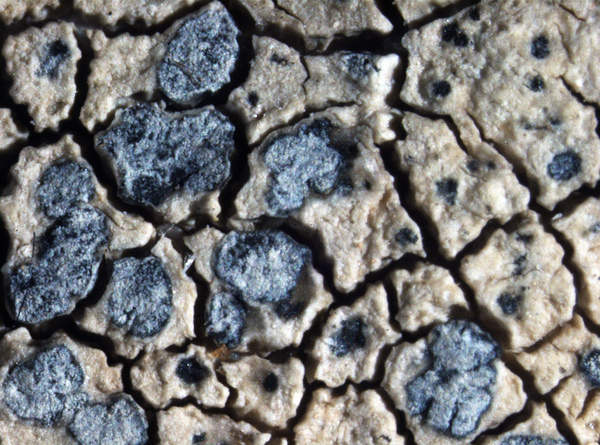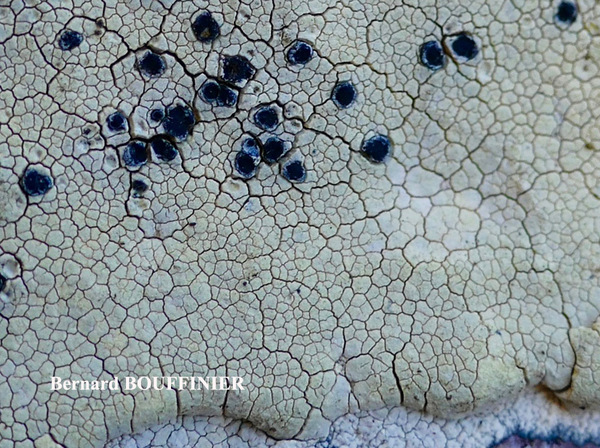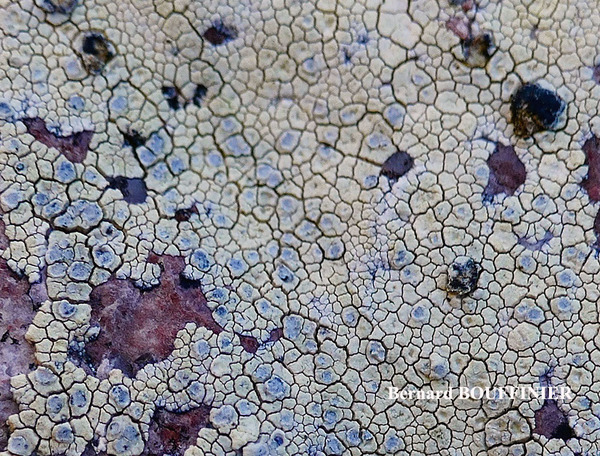Glaucomaria rupicola subsp. sulphurata (Ach.) ined.
provisionally placed here, ICN Art. 36.1b. . Basionym: Lecanora glaucoma var. sulphurata Ach. - Syn. Meth. Lich.: 166, 1814.
Synonyms: Lecanora flavescens (Bagl.) Bagl.; Lecanora rupicola subsp. sulphurata (Ach.) Leuckert & Poelt; Lecanora sordida var. flavescens Bagl.; Lecanora sordidoflava Jatta; Lecanora sulphurata (Ach.) Nyl.
Distribution: N - Piem (TSB 32644), VA (TSB 29483), Lig (TSB 33390). C - Tosc, Laz, Sar (Monte 1993, Nöske 2000, Rizzi & al. 2011, Giordani & al. 2013). S - Bas (Nimis & Tretiach 1999), Cal (TSB 10579), Si (Ottonello & al. 1994, 2011, Grillo & al. 1996, Ottonello & Romano 1997, Grillo 1998, Grillo & Caniglia 2004).
Description: Thallus crustose, episubstratic, finely rimose-areolate to slightly verrucose, yellowish grey to yellowish green, sometimes delimited by a dark prothallus. Areoles flat, ecorticate, smooth, epruinose. Apothecia lecanorine, subimmersed when young, then broadly sessile, (0.5-)1-2(-3) mm across, with a brown, grey-brown or black (in forms parasitized by Arthonia varians), but heavily bluish-white-pruinose, usually flat disc, and a thin, persistent, smooth, sometimes flexuose thalline margin; proper margin not visible macroscopically. Thalline exciple pseudocorticate, with numerous algal cells, containing small crystals soluble in K; proper exciple colourless, lacking crystals; epithecium almost colourless to yellowish or greenish brown, the pigment dissolving in K, with a layer of crystals dissolving in K and reacting C+ yellow; hymenium colourless, 75-95 µm high, not inspersed with oil droplets; paraphyses 2-3 µm thick, the apical cells not or slightly thickened, to 3.5 µm wide; hypothecium colourless. Asci 8-spored, elongate-clavate, very thin-walled, with a K/I+ blue, tall tholus penetrated by a faintly amyloid apical cushion, the wall K/I-, surrounded by a K/I+ blue outer layer, Lecanora-type. Ascospores 1-celled, hyaline, ellipsoid, 9-15 x 5-8 µm, the wall <1 µm thick. Pycnidia immersed, the wall colourless except around the ostiole. Conidia thread-like, sometimes curved, 14-25 µm long. Photobiont chlorococcoid. Spot tests: cortex K+ yellow, C+ yellow, KC+ yellow, P- or P+ pale yellow; medulla C+ and KC+ orange; apothecial disc C+ yellow to orange, P-. Chemistry: thallus with atranorin (major), roccellic acid, chloroatranorin, thiophanic acid, dichlorlichexanthone, 2.5.7.-trichlornorlichenxanthone (the xanthones present also in the cortex); pruina of apothecia with sordidone (major).Note: more southern, more photo- and thermophylous than the typical subspecies; in the Alps it is common only in dry situations, such as on south-exposed faces.
Growth form: Crustose
Substrata: rocks
Photobiont: green algae other than Trentepohlia
Reproductive strategy: mainly sexual
Most common in areas with a humid-warm climate (e.g. most of Tyrrenian Italy)
Commonnes-rarity: (info)
Alpine belt: rather common
Subalpine belt: common
Oromediterranean belt: absent
Montane belt: very rare
Submediterranean belt: extremely rare
Padanian area: absent
Humid submediterranean belt: rather common
Humid mediterranean belt: rather rare
Dry mediterranean belt: extremely rare
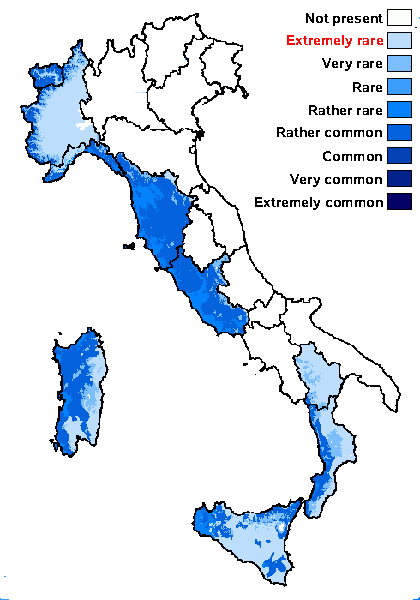
Predictive model
Herbarium samples


P.L. Nimis; Owner: Department of Life Sciences, University of Trieste
Herbarium: TSB (11407)
2002/01/02

Bernard Bouffinier - Source: http://www.lichensmaritimes.org/index.php?task=fiche&lichen=975&lang=en
France, Corse, Haut-Asco
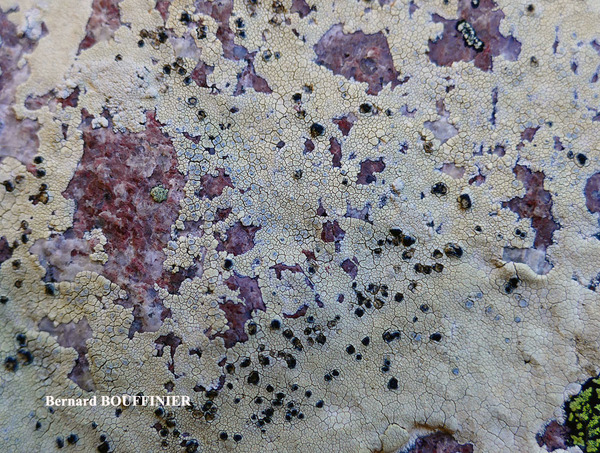
Bernard Bouffinier - Source: http://www.lichensmaritimes.org/index.php?task=fiche&lichen=975&lang=en
France, Corse, Haut-Asco
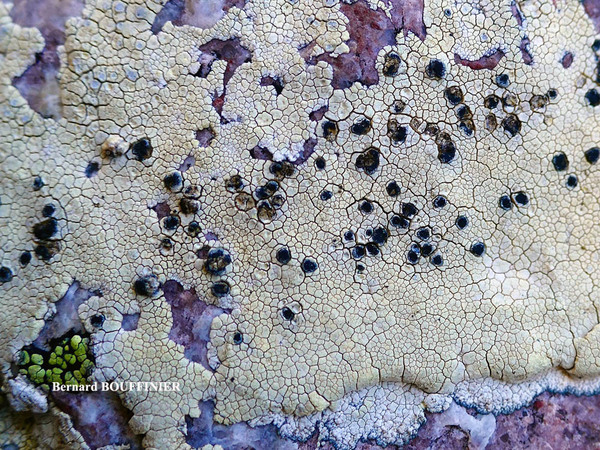
Bernard Bouffinier - Source: http://www.lichensmaritimes.org/index.php?task=fiche&lichen=975&lang=en
France, Corse, Haut-Asco
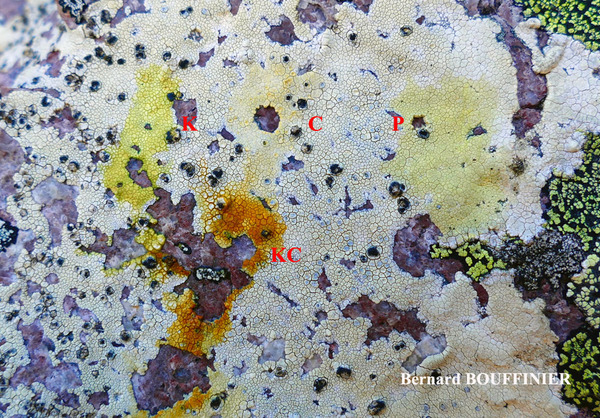
Bernard Bouffinier - Source: http://www.lichensmaritimes.org/index.php?task=fiche&lichen=975&lang=en
France, Corse, Haut-Asco
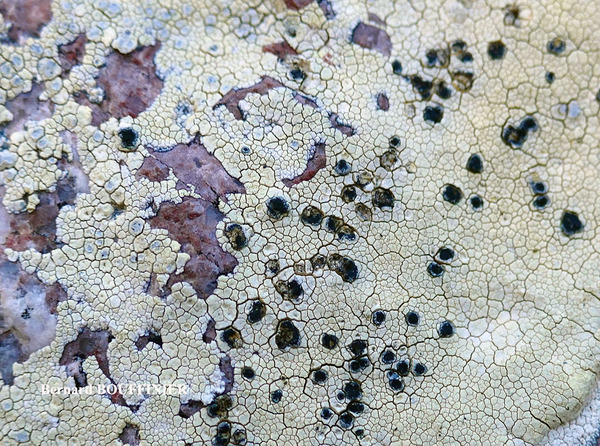
Bernard Bouffinier - Source: http://www.lichensmaritimes.org/index.php?task=fiche&lichen=975&lang=en
France, Corse, Haut-Asco
Growth form: Crustose
Substrata: rocks
Photobiont: green algae other than Trentepohlia
Reproductive strategy: mainly sexual
Most common in areas with a humid-warm climate (e.g. most of Tyrrenian Italy)
Commonnes-rarity: (info)
Alpine belt: rather common
Subalpine belt: common
Oromediterranean belt: absent
Montane belt: very rare
Submediterranean belt: extremely rare
Padanian area: absent
Humid submediterranean belt: rather common
Humid mediterranean belt: rather rare
Dry mediterranean belt: extremely rare

Predictive model
| Herbarium samples |


P.L. Nimis; Owner: Department of Life Sciences, University of Trieste
Herbarium: TSB (11407)
2002/01/02

Bernard Bouffinier - Source: http://www.lichensmaritimes.org/index.php?task=fiche&lichen=975&lang=en
France, Corse, Haut-Asco

Bernard Bouffinier - Source: http://www.lichensmaritimes.org/index.php?task=fiche&lichen=975&lang=en
France, Corse, Haut-Asco

Bernard Bouffinier - Source: http://www.lichensmaritimes.org/index.php?task=fiche&lichen=975&lang=en
France, Corse, Haut-Asco

Bernard Bouffinier - Source: http://www.lichensmaritimes.org/index.php?task=fiche&lichen=975&lang=en
France, Corse, Haut-Asco

 DOLICHENS
DOLICHENS
